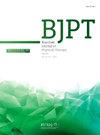Diagnostic accuracy of the flexion-rotation test and cut-off value in acute whiplash-associated disorders: A secondary analysis of a cross-sectional study1
IF 3.1
3区 医学
Q1 ORTHOPEDICS
引用次数: 0
Abstract
Background
Headache is common in people with whiplash-associated disorders (WAD). Upper-cervical structures may be involved in the presence of headache, and the flexion-rotation test (FRT) has been widely studied to assess cervicogenic headaches.
Objectives
To evaluate the diagnostic accuracy of the FRT for the presence of headache in people with WAD, and its cut-off value.
Methods
In this secondary analysis from a previously published study 47 people with WAD were consecutively recruited, 28 with and 19 without headache. FRT was assessed by a single blinded evaluator, with production of headache during the test as the reference standard. Sensitivity, specificity, positive and negative predictive values, and positive and negative likelihood ratios were assessed through cross-tabulation. The cut-off value was calculated based on the Youden's Index. The positivity of the test was defined based on: a) range of motion (ROM) <32°; and ROM <32° combined with headache provocation.
Results
Differences between groups were significant for both most and least restricted sides of FRT in terms of ROM (p < 0.001). For the most restricted side, moderate sensitivity and specificity was found (82.1 % [95 %CI = 68.4 %, 95.8 %] and 63.2 % [95 %CI = 40.8 %, 85.6 %], respectively) when only ROM was considered. When headache provocation was included, sensitivity and specificity were 78.6 % (95 %CI = 63.1 %, 93.7 %) and 68.4 % (95 %CI = 47.5 %, 88.5 %), respectively. A cut-off value of 31.5° was found.
Conclusion
Moderate diagnostic accuracy through both ways of assessing the FRT was found for this test to detect the presence of whiplash-associated headache from upper cervical origin. The FRT may be considered positive if ROM is less than 31.5°.
急性鞭打相关疾病中屈曲旋转测试的诊断准确性和临界值:一项横断面研究的二次分析1。
背景:头痛是鞭打相关疾病(WAD)患者的常见病。头痛的出现可能与上颈部结构有关,屈-转试验(FRT)已被广泛用于评估颈源性头痛:目的:评估屈-转试验对 WAD 患者头痛的诊断准确性及其临界值:方法:对之前发表的一项研究进行二次分析,连续招募了 47 名 WAD 患者,其中 28 人有头痛,19 人无头痛。FRT 由一名单盲评估员进行评估,以测试过程中产生的头痛作为参考标准。通过交叉分析评估了敏感性、特异性、阳性和阴性预测值以及阳性和阴性似然比。临界值根据尤登指数计算。测试的阳性定义基于: a) 运动范围(ROM) 结果:就活动范围而言,FRT 受限最多的一侧和最少的一侧组间差异显著(P < 0.001)。对于活动受限最严重的一侧,仅考虑 ROM 时,灵敏度和特异性适中(分别为 82.1 % [95 %CI = 68.4 %, 95.8 %] 和 63.2 % [95 %CI = 40.8 %, 85.6 %])。当包括头痛诱发因素时,敏感性和特异性分别为 78.6 %(95 %CI = 63.1 %,93.7 %)和 68.4 %(95 %CI = 47.5 %,88.5 %)。结论:结论:通过这两种方法评估 FRT,发现该测试在检测是否存在鞭打引起的上颈椎源性头痛方面具有适度的诊断准确性。如果 ROM 小于 31.5°,则 FRT 可被视为阳性。
本文章由计算机程序翻译,如有差异,请以英文原文为准。
求助全文
约1分钟内获得全文
求助全文
来源期刊
CiteScore
6.10
自引率
8.80%
发文量
53
审稿时长
74 days
期刊介绍:
The Brazilian Journal of Physical Therapy (BJPT) is the official publication of the Brazilian Society of Physical Therapy Research and Graduate Studies (ABRAPG-Ft). It publishes original research articles on topics related to the areas of physical therapy and rehabilitation sciences, including clinical, basic or applied studies on the assessment, prevention, and treatment of movement disorders.

 求助内容:
求助内容: 应助结果提醒方式:
应助结果提醒方式:


